Ruth Ellen Gruber's Blog, page 12
December 29, 2011
Serbia -- Concern at condition of historic Nis Jewish cemetery
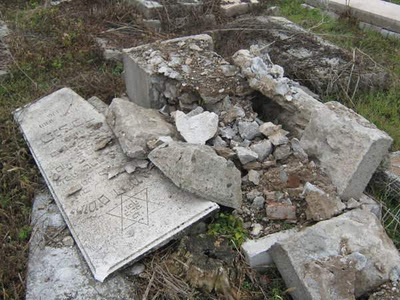 Vandalized tomb in Nis Cemetery, Dec. 22, 2011. Photo courtesy of Jasna Ciric
Vandalized tomb in Nis Cemetery, Dec. 22, 2011. Photo courtesy of Jasna CiricBy Ruth Ellen Gruber
More than seven years after a well-publicized clean-up campaign, the historic Jewish cemetery in Nis, Serbia appears to be once again under threat.
The Federation of Jewish Communities of Serbia issued a statement on Wednesday protesting "catastrophic" conditions in the cemetery and urging authorities to take action.
It said that on a recent inspection visitors found "destroyed and broken monuments, scattered bones, human waste and garbage." It said that the cemetery was at the mercy of private entrepreneurs who have destroyed one-third of the site by building factories, restaurants and warehouses, while another third of the area is inhabited by Roma families who have built a makeshift village over the graves.
Long abandoned and partially built over and destroyed, the cemetery, which dates back to the 17th century and in 2007 was listed as a national cultural monument, was cleaned up in 2004 in an effort that involved the JDC, Serbian soldiers, and the local Roma community.
Pictures taken Dec. 22 showed much of the area cleared of undergrowth and the grave markers visible. But Jasna Ciric, the president of the Jewish community in Nis, told me that the situation today was "a horror" and that in some ways was worse than it was in 2004. "Grave monuments have been smashed with hammers," she said.
She said that on a previous inspection of the cemetery in September, things had been fine and it had been cleaned up.
Now, she said, a telephone line, sewage drains and water pipes have been introduced in the midst of the cemetery.
"All the established safeguards of the Jewish cemetery in Nis, which under the Law on Cultural Property, have remained only on paper and without respect for the Jewish cemetery or the Jews who are buried there," she said. "Our cemetery is systematically destroyed, all of our long-time efforts and the money invested toward saving this cemetery are in vain, the city authorities do not understand this issue."
The Federation appealed to the Mayor of Nis, the Ministry of Culture, the Nis Institute for Monuments Protection and other authorities to "once and for all put an end to this vandalism."
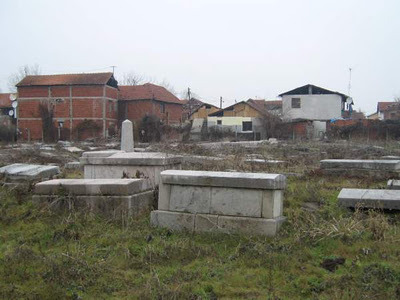
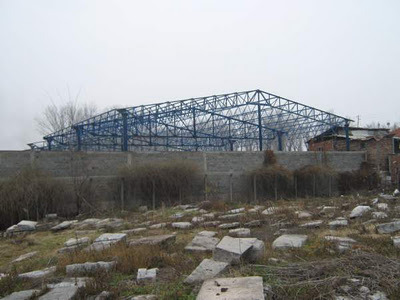 Pictures from Dec. 22, 2011 showing homes and other structures encroaching on the Nis Jewish cemetery. Photos courtesy Jasna Ciric
Pictures from Dec. 22, 2011 showing homes and other structures encroaching on the Nis Jewish cemetery. Photos courtesy Jasna Ciric
Published on December 29, 2011 08:22
December 25, 2011
Netherlands -- In Amsterdam, the Dutch Queen attends reopening of the Portuguese synagogue after restoration
By Ruth Ellen Gruber
Queen Beatrix of the Netherlands attended the dedication ceremony in Amsterdam Dec. 20 of the Portuguese Synagogue -- or "Esnoga" -- which was reopened after renovation. She also attended the the first presentation of the synagogue's treasure rooms with many special ceremonial objects.
The synagogue's web site called the occasion "an important moment in the history of this monumental complex."
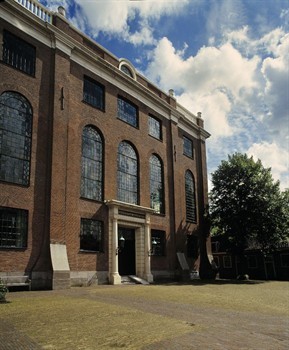 Photo from: www.portugesesynagoge.nl
The "Esnoga" and annexes
Photo from: www.portugesesynagoge.nl
The "Esnoga" and annexes
The main building has undergone quality restoration to the gables, the roofs, the cast-iron windows and the sandstone ornaments. The interior of the synagogue, however, has remained in its original state following the restoration. The building will continue to be lit by nearly one thousand candles in the copper chandeliers.
Treasure chambers
Special climate-controlled spaces will accommodate the valuables of the Portuguese Synagogue. In the future, the concealed treasures will be on public display here.
Queen Beatrix of the Netherlands attended the dedication ceremony in Amsterdam Dec. 20 of the Portuguese Synagogue -- or "Esnoga" -- which was reopened after renovation. She also attended the the first presentation of the synagogue's treasure rooms with many special ceremonial objects.
The synagogue's web site called the occasion "an important moment in the history of this monumental complex."
In January 2010 the current restoration project began. This restoration was necessary because the annexes were in very poor condition and had never previously been restored from the foundations. The aim of the restoration and provision of access was to maintain the Synagogue's authenticity.To see specifics of the restoration, click on the following links:
Renovation of and rearrangement to ensure easy access to the Portuguese Synagogue is a wonderful and unique addition to the city's cultural features. It will reinforce the cultural and economic infrastructure and make the city and region more attractive for residents and visitors. This heritage is unique, in that it remains a lively building with an equally vibrant community that uses it to this day.
The Esnoga is a pearl for Amsterdam and the Netherlands. In use for centuries, it is now literally opening its doors to the general public. Visitors will be able to view the art treasures, which are maintained according to museum preservation standards, in their natural context. The functional areas will also be made visible and accessible to visitors, who will thus feel like guests in the community. Visiting this historic complex is like taking a stroll through the past and present of a community that has been celebrating its religion and culture for three centuries within these walls.
 Photo from: www.portugesesynagoge.nl
The "Esnoga" and annexes
Photo from: www.portugesesynagoge.nl
The "Esnoga" and annexes
The main building has undergone quality restoration to the gables, the roofs, the cast-iron windows and the sandstone ornaments. The interior of the synagogue, however, has remained in its original state following the restoration. The building will continue to be lit by nearly one thousand candles in the copper chandeliers.
Treasure chambers
Special climate-controlled spaces will accommodate the valuables of the Portuguese Synagogue. In the future, the concealed treasures will be on public display here.
Published on December 25, 2011 07:00
December 24, 2011
Jewish and "Jewish" Festivals......Shelly Salamensky's Take
By Ruth Ellen Gruber
My friend Shelley Salamensky muses on three Jewish -- or "Jewish" -- festivals: Krakow, Birobidzhan and Hervas, Spain, in the New York Review of Books blog.

My friend Shelley Salamensky muses on three Jewish -- or "Jewish" -- festivals: Krakow, Birobidzhan and Hervas, Spain, in the New York Review of Books blog.
The commercial aspects of Hervás's festival—funded by the village's chamber of commerce as a boon to local business—are hardly unique. Birobidzhan's cultural renaissance, has, similarly, garnered it development grants from Moscow; while on the fringes of the Kraków festival, stands sell hook-nosed "Jew" figurines. Yet much more is at stake in both places than profit. In Kraków, with its rich, traumatic history, the festival is an attempt to confront the still relatively fresh loss of what was once the world's largest Jewish population, as well as the question of Polish complicity with Nazis in the war, communist suppression of Holocaust history, and continuing European intolerance; it's also a chance for Poles to reflect on their country's future as a conservative, culturally monolithic nation in a changing, diversifying Europe. Birobizhan's Jewish cultural revival appears primarily to enliven an isolated, poor, rather bleak place unremarkable but for its unique history. Despite some silliness and confusion, the more sober efforts to teach Yiddish and Jewish history ensure that important legacies are preserved. And perhaps even theme-park-style memorialization is more salutary than the more common case in places from which vital cultures have more or less vanished: sheer oblivion.
In Hervas, the evocation of a Jewish past is so perfunctory and historically fanciful as to border on the offensive. Stars of David adorn street signs, window grates, and even, for no clear reason, the church. There is a Judería Tavern and a Hotel Sinagoga: the former, on inspection, specializing in ham, the latter indistinguishable from a Holiday Inn. On arrival, I was amused by the kitsch; but by my last day, I felt vaguely sick. The empty symbolism cruelly underscored all that Europe has lost.
Published on December 24, 2011 09:51
December 22, 2011
Very off geographical topic -- synagogue in Mumbai celebrates 150th anniversary
A ceremony Tuesday celebrated the 150th birthday of the Magen David synagogue in Mumbai, India. The synagogue, which underwent restoration last year, was built in 1861 by the philanthropist David Sassoon at a time when hundreds of Baghdadi Jews were migrating to India to escape religious persecution.
"This is probably the largest synagogue in India and, if you exclude those in Israel, probably the largest in Asia," Solomon Sopher, chairman and managing trustee of the Sir Jacob Sassoon Charity and Allied Trusts, told India's Daily News & Analysis news agency.
He told the Mumbai Mirror (which also publishes a picture of the ceremony): "The Magen David synagogue is easily the biggest in India. Its beauty has been enhanced after the second renovation last year, at the cost of Rs 70 lakh." He said the first renovation of the synagogue was done in 1910 by David Sasoon's grandson Jacob.
"This is probably the largest synagogue in India and, if you exclude those in Israel, probably the largest in Asia," Solomon Sopher, chairman and managing trustee of the Sir Jacob Sassoon Charity and Allied Trusts, told India's Daily News & Analysis news agency.
He told the Mumbai Mirror (which also publishes a picture of the ceremony): "The Magen David synagogue is easily the biggest in India. Its beauty has been enhanced after the second renovation last year, at the cost of Rs 70 lakh." He said the first renovation of the synagogue was done in 1910 by David Sasoon's grandson Jacob.
Published on December 22, 2011 03:15
December 11, 2011
Slovakia -- New Jewish Guidebook
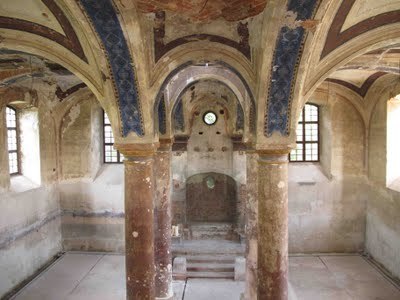 Synagogue in Stupava. Photo (c) Ruth Ellen Gruber
Synagogue in Stupava. Photo (c) Ruth Ellen GruberBy Ruth Ellen Gruber
Mazel tov to Maros Borsky on the publication of his valuable new bilingual Slovak-English guidebook to Jewish Monuments in western Slovakia. Zidovske pamiatky zapadneho Slovenska/Jewish Monuments of Western Slovakia was launched last week in Bratislava and Trnava.
A slim paperback illustrated with full-color pictures of each site, the book provides details -- including GPS coordinates -- for Jewish heritage sites in more than two dozen other towns in Slovak regions of Bratislava and Trnava, giving basic history and current details.
Most of these sites are off the beaten track and not included on the Slovak Jewish Heritage Route, a network of 25 key sites around the country.
Published on December 11, 2011 08:46
Amsterdam -- slice of history
By Ruth Ellen Gruber
Nir Hasson reports in Ha'aretz how the discovery of a 25-year-old book in Israel reveals a fascinating slice of the Jewish history of Amsterdam -- as well as a clutch of mysteries.
Read the article on Ha'aretz
Nir Hasson reports in Ha'aretz how the discovery of a 25-year-old book in Israel reveals a fascinating slice of the Jewish history of Amsterdam -- as well as a clutch of mysteries.
Friday June 3, 1768, was an exciting day in the sizable Jewish community of Amsterdam. That day, the Stadtholder (chief executive) of Holland, William V of the House of Orange, arrived for a rare visit to the Jewish quarter and the synagogue, accompanied by his wife, Wilhelmina of Prussia. "Their Highnesses sat on the bench of the community elders, the other ministers and dignitaries were seated on two velvet benches on the north and south sides of the synagogue. As they entered the synagogue, the Holy Ark was opened, the cantors and vocalists had begun to sing 'Baruch Haba' [Welcome]" [...].
Stefan Litt, an archivist at the National Library in Jerusalem, found this description in the course of his research into the registries of the Ashkenazi communities (pinkassei kahal ) in the 17th and 18th centuries. The registry goes on to note that a community elder, Gumpel Klev, bestowed on the royal couple a keepsake from the community: "Two books printed on white satin, the cover pages beautifully ornamented with their insignia."
Two weeks ago, Litt located one of these two books, which were printed on cloth nearly 250 years ago, in the storerooms of the National Library in Jerusalem. Did the Stadtholder leave the book on his seat when he got up to leave? What was scribbled in Dutch on the last page? And why was this scribble erased? Why are there traces of one of the pages being singed? How did the book make its way to the National Library? All of these matters are still shrouded in mystery.
Read the article on Ha'aretz
Published on December 11, 2011 02:56
December 9, 2011
Poland -- Aleksander Hassidim
By Ruth Ellen Gruber
An article in the Jerusalem Post by Levi Cooper gives fascinating background on the Aleksandrow Hassidim, who still make pilgrimages to the small town of Aleksandrow Lodzki to visit the grave of the founding Aleksander rebbe, Rabbi Yehiel Dancyger (1828-1894), and his sons. In January 2010, more than 300 Aleksander Hassidim traveled to the town to mark the 100th anniversary of Yehiel's son, Rabbi Yerahmiel Yisroel Yitzhok. The only physical traces left in the town are the cemetery and the former residence of Yehiel's grandson, Rabbi Yitzhak Menahem Dancyger (1879-1942), who was killed in Treblinka.
Read full story HERE
An article in the Jerusalem Post by Levi Cooper gives fascinating background on the Aleksandrow Hassidim, who still make pilgrimages to the small town of Aleksandrow Lodzki to visit the grave of the founding Aleksander rebbe, Rabbi Yehiel Dancyger (1828-1894), and his sons. In January 2010, more than 300 Aleksander Hassidim traveled to the town to mark the 100th anniversary of Yehiel's son, Rabbi Yerahmiel Yisroel Yitzhok. The only physical traces left in the town are the cemetery and the former residence of Yehiel's grandson, Rabbi Yitzhak Menahem Dancyger (1879-1942), who was killed in Treblinka.
Rabbi Yehiel requested not to be accorded any rabbinic title and asked his followers not to place notes with requests on his grave as is traditionally done with a hassidic master. Aleksander Hassidim, therefore, bring such notes to the grave, read them out and then, in accordance with the wishes of Rabbi Yehiel, they do not place them on the grave. Rather, they place them on the nearby grave of Rabbi Heynech.The article traces the complex history of the dynasty and describes the situation today, with centers in Israel and the U.S.
Read full story HERE
Published on December 09, 2011 01:11
December 3, 2011
UK -- More on London's East End
By Ruth Ellen Gruber
Here's another detailed travel story (in Jewish Week) about London's former Jewish quarter, the East End. The author, Stephen Burstin, conducts Jewish themed tours. For more information, click HERE

Here's another detailed travel story (in Jewish Week) about London's former Jewish quarter, the East End. The author, Stephen Burstin, conducts Jewish themed tours. For more information, click HERE
The oldest surviving synagogue in England, Bevis Marks, today straddles the border between the East End and the city's financial district. Founded in 1701 primarily by Dutch Jews whose descendants had fled the Spanish Inquisition, it is Sephardic. Its original interior is perfectly intact, including the beautiful Renaissance-style ark.
Bevis Marks boasts several famous sons, most notably the 19th-century British Prime Minister Benjamin Disraeli, whose father turned his back on Judaism and converted the family to Christianity when Benjamin was 12. This did not stop an Irish member of Parliament from later insulting the young politician's Jewish roots. But Disraeli famously retorted: "Yes, I am a Jew. But while the right honourable gentleman's ancestors were brutal savages in an unknown island, mine were priests in the Temple of Solomon."
Many sites in the East End continue to provide reminders of the neighborhood's rich Jewish heritage; at one time Jews made up 95 percent of the population. There's the soup kitchen that served 5,000 meals a day during the Depression years; now, paradoxically, its retained ornate facade provides a frontage to luxury apartments. Across Commercial Street in revitalized Spitalfields, $1.5 million homes vie with each other to maintain the best-kept Jewish secrets from unknowing passers-by.
Published on December 03, 2011 08:33
December 2, 2011
Poland -- Restoration Work Completed on pre-war Private Synagogue in Bedzin
By Ruth Ellen Gruber
Restoration work has been completed on a richly decorated private Jewish prayer room in Bedzin, in southern Poland. The so-called Mizrachi synagogue, believed to date from the mid-1920s, is located in a building at ul. Potocki 3 in the former Jewish quarter. It was used by the members of the Mizrachi religious Zionist organization. The founder was probably the owner of the entire building, a man named Wiener, who was active in the movement.
The prayer room will be opened to the public in the spring.
The Bedzin town web site has a slide show of pictures showing the completed work -- you can view it HERE
There are also a lot of pictures on Wiki commons of the "before" condition
 Photo (c) Leszek Maszczyk
Photo (c) Leszek Maszczyk
The photographer Jono David has also posted four dozen pictures documenting the poor state of the synagogue when renovation began and then the painstaking process of restoration. You can see them HERE
It is the second private prayer house in Bedzin to be restored recently. The other is under the care of a private organization called Cukierman's Gate. I have posted about them in the past HERE.
Restoration work has been completed on a richly decorated private Jewish prayer room in Bedzin, in southern Poland. The so-called Mizrachi synagogue, believed to date from the mid-1920s, is located in a building at ul. Potocki 3 in the former Jewish quarter. It was used by the members of the Mizrachi religious Zionist organization. The founder was probably the owner of the entire building, a man named Wiener, who was active in the movement.
The prayer room will be opened to the public in the spring.
The Bedzin town web site has a slide show of pictures showing the completed work -- you can view it HERE
There are also a lot of pictures on Wiki commons of the "before" condition
 Photo (c) Leszek Maszczyk
Photo (c) Leszek MaszczykThe photographer Jono David has also posted four dozen pictures documenting the poor state of the synagogue when renovation began and then the painstaking process of restoration. You can see them HERE
It is the second private prayer house in Bedzin to be restored recently. The other is under the care of a private organization called Cukierman's Gate. I have posted about them in the past HERE.
Published on December 02, 2011 09:02
Kosovo -- Jewish cemetery vandalized
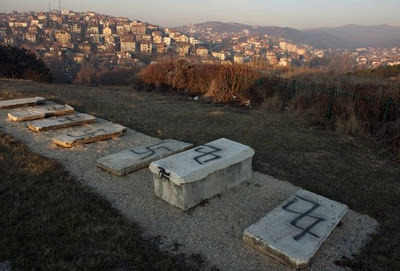 Photo from http://www.kurir-info.rs
Photo from http://www.kurir-info.rsBy Ruth Ellen Gruber
Vandals have descerated the recently restored Jewish cemetery in Pristina, the capital of Kosovo, by scrawling anti-Semtic slogans and swastikas on the tombs. Officials condemned the desecration, and police are investigating.
The Associated Press reports:
Read full article HERE
In June, a group of students from Dartmouth College in New Hampshire and their peers from the American University in Kosovo restored the neglected cemetery by clearing debris from around the graves and cutting overgrown grass.
Rabbi Edward S. Boraz of the college's Roth Center for Jewish Life held a dedication ceremony at the memorial site, with students taking turns to read out the names of Jewish families from the region who perished during World War II.
On Thursday the hate graffiti "Jud Raus" — a misspelling of the German "Juden Raus," which means "Jews out" — could still be seen at the foot of a memorial.
President Atifete Jahjaga and Prime Minister Hashim Thaci condemned the act.
"The damaging of cemeteries presents an act in complete contradiction with the traditions and values of the people of Kosovo, based on tolerance and full respect for all the dead and all the monuments," Jahjaga said in a statement.
Thaci described the desecration as "a cowardly act."
Published on December 02, 2011 01:15



